
The Liquefied Petroleum Gas shipping market
in 2005
'Ever higher or already on top?'
SIGNIFICANT EVENTS
As we anticipated at the same time last year, the LPG market has been experiencing a sustained activity over these past twelve months, as well as a broadening of the strong upward trend that began in mid 2004.
All the evidence that allowed us to anticipate a continuation of this tendency has combined to evolve in a predictable manner, fortifying the basis of a revival which was long-awaited by the shipping community. Only the extent of this revival, which all agree was inevitable, remained to be determined.
Let us briefly recapitulate the fundamental factors and recent evolutions, as they will continue to leave their mark on the market in the coming years:
1. Closer commercial contact between owners and operators of ships already involved in the sector had previously been initiated, in the context of a depressed market, in order to optimise operations and to increase their coverage of a given traffic within a specific size segment. These diverse consolidation moves, which had been undertaken some years ago by industry Majors, will probably be modified with the arrival of new players having acquired existing ships or ordered newbuildings, most of which still to be delivered. New investments have been committed by some operators who are taking position in new sectors, trades, or sizes of ships, which will change the configuration within sectors and multiply the supply sources of ships.
2. Newbuilding orders, whose level remained low when the market was depressed, as well as an increase in new investments in this sector since mid 2004, have resulted in few new deliveries over the course of 2005, due to delays brought about by the shipyards. The next two to three years will see a real replenishment of the fleet, starting in 2006 with deliveries of the orders signed in 2004, followed to a far greater extent with 2005 orders, which will bring ships into service during 2007, 2008, and even 2009! Some size categories, notably the small pressurized or semi-pressurized ships of 4,000 to 8,000 cbm, were less affected by the delays in deliveries from the shipyards, and few new ships will be operational as from the end of 2006.
3. Scrapping, which was well-sustai-ned these past two years, has been limited these last twelve months. We have only registered six demolitions, all done in the first half of the year, including four small ships of 4,000-6,000 cbm, one of 20,000 cbm and one of 75,000 cbm, whereas some twenty units were sold for demolition the previous year. The strength of the market has obviously made certain operators hesitating to scrap their vessels, especially those who invest heavily in maintenance costs' The strict application of standards and quality controls, combined with age limitations, should, however, favour demolitions in the coming years, as well as the newbuildings joining the trade.
4. The very strong surge in American imports, principally ammonia whose production is linked to the price of natural gas: the Henry Hub spot price has jumped from $ 7.80/mmbtu in December 2004 to nearly $ 13.75/mmbtu in December 2005, an increase of around 75 %! Trade volumes have practically doubled over the last months. The current nervousness of the energy market in general would suggest that this trend might amplify, even if the growing volumes of natural gas due to be imported into the US should theoretically take off some of the pressure in the long term. One should also note the disruption of import and export to and from the US, caused by the hurricanes Katrina, Rita, Cindy and Denis, which hit the Gulf of Mexico between July and September. They resulted in lower propane production and important distribution problems during the last half of 2005.
5. The logistics of transporting gas between production and consumption zones is changing. The arrival, over the next few years, of important volumes of gas, including LPG, often associated with new LNG production in West Africa, North Africa, Qatar, Abu Dhabi, and Egypt towards the traditional major poles, and new consuming zones of emerging countries, will cause a change in the movements of numerous ships over longer and considerably different routes. The ammonia and chemical gas sectors are also becoming more and more implicated by this global redistribution, making them more vulnerable to international market fluctuations, whereas, up until now, they have only been limited to specific geographical zones. The development of longer voyages will continue to reinforce the ton-miles factor on these markets.
6. The increase of demand within Far Eastern countries and all the emerging countries such as India, based on oil products and other raw materials, has remained very sustained. There has been, however, a certain easing off in the growth of Chinese energy imports as a result of the development of domestic production.
7. Crude oil and oil product prices have continued to increase, directly affecting those of bunkers ' whose level, based on the selling price at Fujairah, has gone from $ 170 per ton in December 2004 to nearly $ 300 per ton in December 2005, an increase of nearly 175 %!
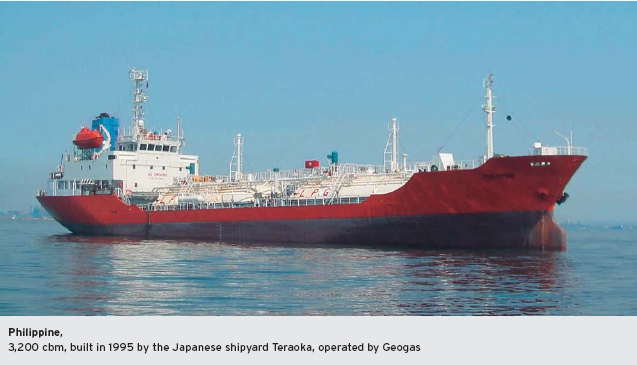
* * *
We could continue to list other factors that have contributed to the revival of the LPG market and which are likely to influence the future, but we have contained ourselves to the principal ones and, more especially, to those whose levels or prices have reached 'peak' or possibly 'ceiling' levels.
Parallel to the freight market, which has experienced this continuous rise throughout the year, product prices have also increased considerably despite extensive volatility, which has allowed operators to hedge movements between the various continents. For example, the $ 600 per ton mark was broken at the end of the year for butane deliveries C + F into the Far East, whilst that of propane exceeded $ 650 per ton into North Europe!
Our usual table shows the evolution of prices for few oil products and gas related products over the last three years:
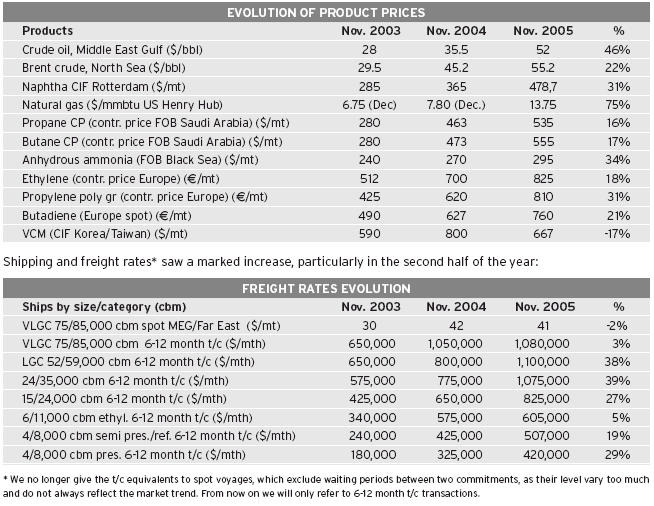 SITUATION BY VESSEL SIZE
SITUATION BY VESSEL SIZE
VLGC (Very Large Gas Carriers) from 70,000 to 85,000 cbm
The share of units employed in transporting naphtha diminished, reaching a level of 2-4 ships at the end of the year, given the improvement in LPG freights compared to naphtha rates. There was a high volatility in this market. The spot reference rate MEG/Japan varied from $ 30 to $ 40 per ton in the first quarter, then down to $ 30/t in mid July to peak at over $ 60 in mid September. It dropped to $ 35/t in November, before climbing to nearly $ 50/t at the beginning of 2006! Some exercise for traders who are often confronted with term positions!
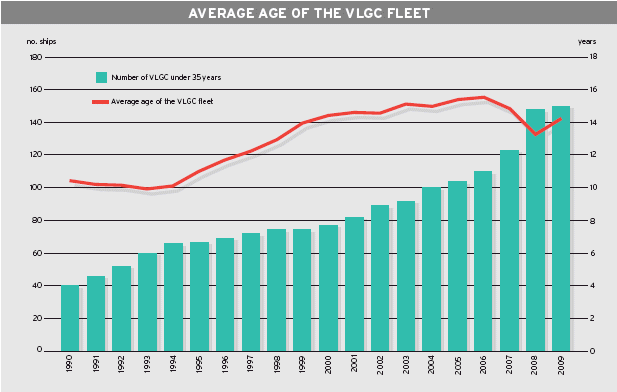
Forecasts for strong increases in LPG production in the coming years continue to promote new orders at higher and higher levels, now reaching over $ 90 million per unit. Some 26 orders were signed in 2005 for a total capacity of 2.15 million cbm, compared to an existing fleet of 104 ships, representing a total of 8 million cbm. For reference, orders in the year 2005 totalled over twice as much as the preceding year, and three times more than that of 2003, whilst building prices have gone up by an average of 35 %!
Construction costs of over $ 90 million should normally translate into higher freight rates, to the extent that transport demand should remain surplus and we should not see a situation such as the one that exists in the LNG sector with delays in bringing new sites into operation. Some 46 VLGCs remain to be delivered over the next four years.
In conjunction with the traditional players in the sector such as Berge-sen, Exmar, or A.P. M'ller, several newcomers, owners or trader-owners such as BP, Petredec, Dorian, Latsis, Angelicoussis / Marangas, QGTC, have invested in the VLGC sector.
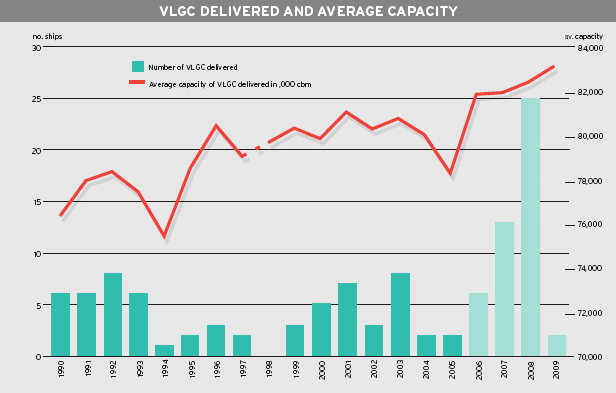
There were limited long term charters in the first three quarters of the year, but same became more numerous at the end of the year, at which time the levels awarded were close to a million dollars, more or less 5 % depending on the specifi-cations of the ship and the period concerned.
Recent term charters have been:
'Joyama' - 82,500 cbm ' t/c 2 years delivery Dec. 05 900,000 $/mth ' Ferrel
'Gas Diana' - 78,000 cbm ' t/c 3 years delivery Dec. 05 950,000 $/mth ' APM
'Gas Energy' - 78,000 cbm ' t/c 18 mths delivery Dec. 05 1,050,000 $/mth ' HMM
'BW Broker' - 80,000 cbm ' t/c 10 years delivery June 07 700,000 $/mth ' BW
Also worth noting some secondhand sales structured around medium or long term charters with purchase options:
the 'Berge Trader', a new Geogas ship, 78,500 cbm, for delivery in June 2006, fixed for a time charter of 5 years to Bergesen with an option to buy after the first year at $ 92 million, all combined with a COA from Bergesen to Geogas;
the 'BW Broker', a new ship from Zodiac, 80,000 cbm, for delivery in June 2007, fixed bareboat to Bergesen with an option to buy at $ 50 million after 10 years.
Large Gas Carriers from 52,000 to 60,000 cbm
We have often remarked that this size category has benefited, and continues to benefit from the domino effect between the VLGCs and the Midsize sector of 30,000 to 40,000 cbm on some very sensitive trades with increased volumes of ammonia on transatlantic routes (Black Sea or Baltic to the US) and on those from the new producers (Australia, Iran, etc.).
Despite some periods of inactivity, levels have risen appreciably during the last quarter, with spot market rates of ammonia Black Sea/US going from $ 60 to $ 120 for lots of 35,000 tons! The tightness of this market has led some Majors and Traders to take term positions at t/c rates close to a million dollars per month, preferring thus not to be at the mercy of lacking transport capacity at a given moment or not to be confronted with spot rates where the equivalent time charter levels sometimes exceed $ 1.4 million or even $ 1.5 million!
The end of the year was marked by the order of eight newbuildings with a capacity of 60,000 cbm with Hyundai for deliveries spread over 2008 and 2009, at a price around $81 million each, with three units for Solvang and three for General Ore (Neu Schiffahrt).
The average age of this fleet (15 years) and some ten units of 25 years or more, which are still trading ammonia but are due to disappear shortly, was largely the reason for such a decision, even at a record construction price of over $80 million!
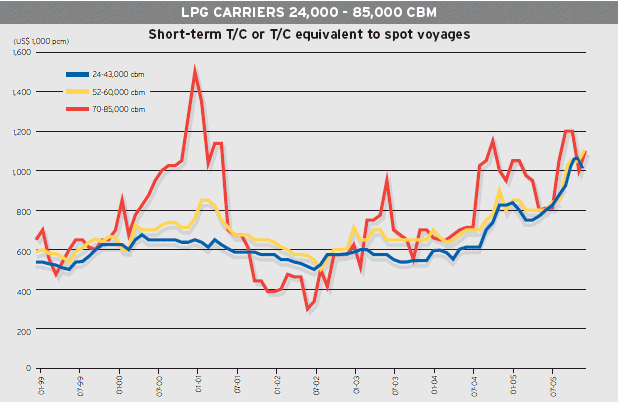
Recent transactions:
'Hugo N' - 35,000 t ' NH3Yuzhny/USG Jan 06 ' $ 120/t ' Transammonia
'Havdrott'- 54,000 cbm ' NH3 ' 12 months Dec 05 ' $ 950,000/m ' Harvester
Midsize carriers from 24,000 to 43,000 cbm
Compared to the other sizes, this sector started from a more sustained level at the beginning of 2005, which explains why the variations were not as great. This category is always favoured, with a growing demand both from the ammonia sector as well as LPG, mainly on traditional routes: out of the Caribbean to the US, including the West Coast, and from the Middle East to the Indian Ocean or the Far East.
Ammonia prices reached their peaks with FOB Black Sea being close to $ 300/t, whereas the CIF US surpassed $ 410/t in the month of November.
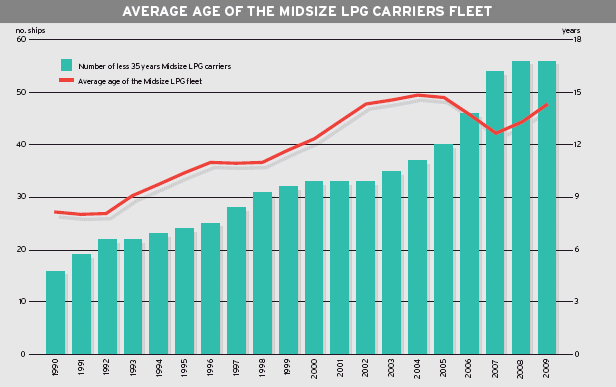
Freights were frequently tight, which, during the second half of 2005, resulted in a multitude of transactions on term business, concluded by some Majors and Traders who sought cover for three, five, even ten years, to benefit from more attractive rates than those on the spot market which remained limited in this size category, not much from a lack of cargoes but rather from a lack of available ships!
With demand being firmer, the programmed arrival of new tonnage, starting from the year 2006 and particularly in 2007 and 2008, has not affected the trend. However, the increase in the number of operators means that the control of ships and market coverage will probably be more and more diverse.
The average rise in time charter rates since the beginning of 2005 is between 30 and 40 %, depending on sizes and specifications of the ships concerned, which, in fact, for a 35,000 cbm represents a monthly rate of $ 1.15 million for a 12 year period, with some rebate for longer term contracts from 3 to 10 years.
Freight rates of ships ranging between 24,000 and 28,000 cbm rose to levels above $ 900,000 before the winter season, thus leaving one to predict possible future tightness should the coming months be harsh.
Operators who are due to take delivery of their new 35,000 cbm ships in 2006 are looking to place them on time charters at rates of around $ 900,000 to $ 950,000 per month with 3 to 5 year charters. The few spot transactions, given the limited number of ships operating in this sector, are being negotiated at equivalent time charters above $ 1.2 million for a standard ship of 35,000 cbm.
Seven ships changed hands in 2005, with notably the sale of three units of Bibby to Exmar and Bergesen, as well as the four 35,000 cbm of A.P. Moller to the Indian owner Varun.
Sixteen new orders will be delivered in the next three years, of which 6 in 2006, 8 in 2007 and 2 in 2008 for a volume of 578,000 cbm, which signifies that 2007 should be a swing year, given the number of new ships due to enter the market. Some analysts are trying to claim that these new units will be quickly absorbed in the market due to the scrapping of older units in the fleet and the increase in the demand of transport from the emerging countries and inter-continental movements.
The current fleet consists of 40 units with a volume of around 1.3 million cbm.
Some recent transactions:
'Camberley' - 35,000 cbm ' t/c 3 years del. March 06 ' $975,000/mth Bakri/Sabic
'Herakles' - 30,455 cbm ' t/c 3 years del. Jan. 06 ' $975,000/mth Keytrade
Handysize gas carriers from 12,000 to 22,000 cbm
The gradual resumption of chemical gas movements, principally long haul trans-Atlantic and trans-Pacific, combined with sustained demand from the LPG and ammonia sectors has also helped to contribute to price increases throughout 2005.
Ships of 20,000 to 22,000 cbm, which began the year with rates in the range of $ 650,000/700,000 per month, reached during the course of the year more than $ 850,000, on the basis of one year time charter, while the equivalent t/c rate for spot voyages for chemical gas was established at levels above a million dollars (always on the basis of a round trip, one voyage, without counting eventual waiting time).
The last quarter saw rates strengthen further to reach levels above $ 900,000 on the basis of a one year time charter and more than $1.4 million for the equivalent t/c on spot voyages for chemical gas or LPG!
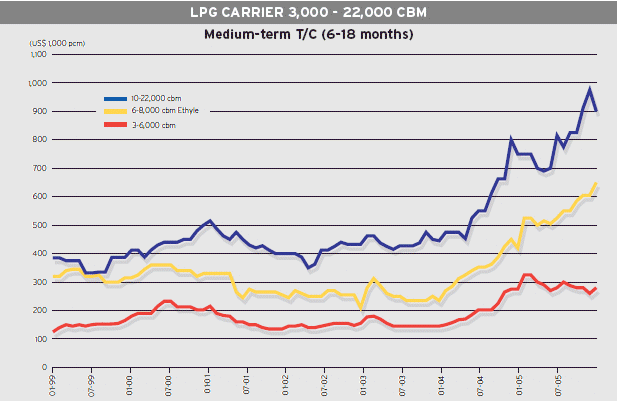
Rates in this size category will probably remain very firm over the next few years, due to very few newbuildings (eight units of 16,000 to 22,000 cbm, of which six ethylene carriers). World demand, coming from the LPG, chemical gas, and ammonia sectors, is continuously growing and this size of ship is used in all three product sectors on intra-regional or coastal traffics.
We saw an interesting order of four ethylene carriers of 17,000 cbm by the Norwegian owner Solvang, placed at the German shipyard Meyer, at a record price close to $ 50 million euros per unit! An interesting commitment for a most probable promising project!
Three semi-refrigerated ships of 22,500 cbm were reported ordered by Navigator and associates (ex Hyundai) for delivery in 2008, but this does not seem to have been confirmed yet, meaning perhaps that the slots will be allocated to others on different ship sizes.
Amongst last year's sales, that of Naftomar's 'Queen Zenobia' to the German owner Harpain, 22,500 cbm semi-ref built in 2002, for a record price of $ 61.5 million, was outstanding in that this was nearly $ 15 million more than the previous ship of this type, and nearly $ 30 million more than the price Naftomar paid when ordering in 2000! This type of transaction is typical of the confidence that some operators are giving to this segment size for the future. The Gaschem Hamburg pool, of which Harpain is a partner, will take commercial management of the ship, which should be delivered at the end of March 2006. It will be the most important unit in the pool, which up until now has had smaller sizes. A new player in this size category.
Recent transactions:
'Annapurna' - 22,000 cbm ' 1990 ' 12 mths Jan. 06 ' $900,000/mth HPCL
'Navigator Nep' - 22,000 cbm ' 2001 ' 12 mths ext Jan. 06 ' $885,000/mth Geogas
'Vidzeme' - 20,700 cbm ' 1997 '12 mths Dec. 05 ' $880,000/mth Naftomar
'Sussex'-'Surrey' - 15,000 cbm ' 1981/82 12/12 mths Dec. 05 ' $685,000/mth Transammonia
Small gas carriers from 3,500 to 12,000 cbm
The year was marked particularly by moves of fleet concentrations and new acquisitions, lead by certain owners which were absent up till now or only present in a marginal manner in the gas sector, such as Stealth, Eitzen, Magnus, Samos, etc.. We have seen the important show of strength of Stealth, which has moved from a fleet of 10 units at the end of 2004 to a fleet of 27 units at the end of 2005 (all ships in the size range of 1,300 to 7,500 cbm, pressure or semi-pressure/refrigerated).
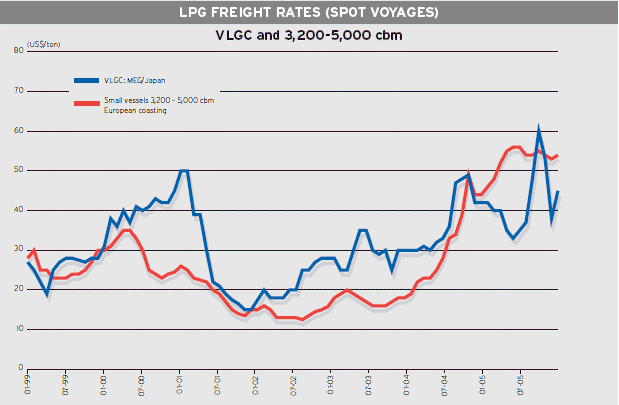
On the other hand, Exmar has relinquished its fleet of small pressurized coasters (9 ships of 3,500 cbm) to partners/owners in the Unigas pool, who have elected to leave the commercial management of their ships to the former pool with Lauritzen Kosan.
More recently, the Italian owner Montanari also decided to leave this sector, having ensured a good price for the sale of its fleet of ten ships of 4,000 to 9,000 cbm to other Italian interests. The latter, new entrants in this sector, will, however, leave the management of their ships to the Gasmare/Gaschem pool.
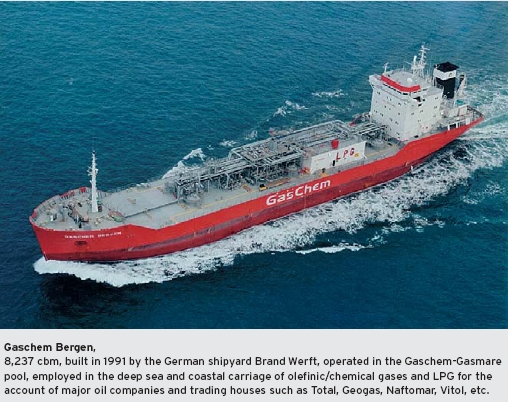
Freight rates for these small pressurized ships of 3,500 to 4,000 cbm have scaled new 'peaks', surpassing the $ 300,000 per month mark mid year, but fell back to levels 25 % lower to these records at the end of the year. The coastal market has remained firm and was very active throughout 2005, also helped by the hike in bunker prices, which increased by more than 175 % during the same period.
The more sustained activity of the ethylene market allowed all ethylene carriers to be employed on international trades, thus reducing their availability for other markets and products, despite some periods of inactivity.
The market of small semi-refs did not take off indefinitely, as some people were expecting at the end of last year. Rates remained firm, however, despite a certain lack of molecules (propylene and VCM) which increased waiting times between voyages.
New ethylene production capacities coming into service over the course of the next few years will be substantial, and it has motivated several players to order ethylene carriers. In total more than twenty ships of this type, of different sizes ranging from 5,600 to 10,000 cbm, have been ordered by seven different owners, at price levels varying between $ 25 to $ 40 million each, depending on size and specifications. These orders are spread between European shipyards for the smaller sizes, and the Korean or Chinese shipyards for the larger sizes. Confidence is therefore strong, comforted by some impressive figures on production forecasts out of the Middle East and the growing demand in Asia.
Apart from ethylene carriers, the sector of newbuildings has been dominated by the pressurized ships, with some 42 units of 3,500 to 11,000 cbm ordered mainly with the small Japanese shipyards offering deliveries as from 2007, based on standard conditions of medium term charters with purchase options. Have past lessons already been forgotten?
Most of these ships were ordered at price levels 40 % above those of 18 months ago! With such price levels, operating these ships will have to be sharp!
Recent transactions:
'Kempton'- 6,400 cbm ' 2000 ' prs ' 6/9 mths Nov. 05 ' $440,000/mth ' Aygas
'Norgas Challenger' - 6,300 cbm ' 1984 ' ethy ' 12 mths ext Jan. 06 ' $450,000/mth ' Mitsui
'Newmarket' - 6,250 cbm ' 1999 ' sr ' 12 mths Jan. 06 ' $430,000/mth ' A. Veder
'Gaschem Atrice' - 7,650 cbm ' 1984 ' vcm ' 12 mths Jan. 06 ' $485,000/mth ' Primex
'Riogas' - 7,300 cbm ' 1986 ' sr ' 2 mths Dec. 05 ' $550,000/mth ' Primex
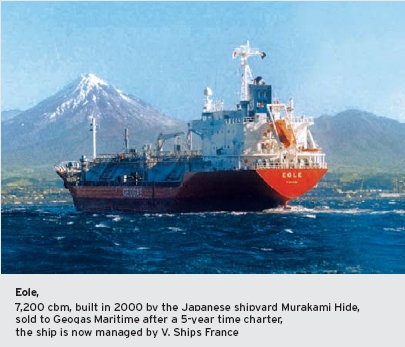 CONCLUSION
CONCLUSION
2005 was strongly marked by the confirmation of the revival of the various liquefied gas markets, whose main product prices and freight rates attained new heights. Will these soon be considered as 'ceiling' levels?
Some operators in well defined sizes seem to think of this as the case, judging by some of the 'departures' seen during the course of the second half, or do they consider that other investments will be less risky or more favourable in the coming years?
Others have taken the inverse position by entering into this market through the acquisition of secondhand ships, or by placing new orders at record prices!
The FOB Saudi-Arabia contract prices of butane and propane were $ 585 and $ 575 respectively at the end of the year, whereas they were only $ 372 and $ 365 a year before, being an increase of 57 %!
CIF prices have followed the same direction, with sometimes even greater increases, whereas those of freights have, on average, been less pronounced, being in a bracket of 25 to 50 % depending on the sizes and the types of ship being considered.
We should again underline the very strong surge in bunker prices (nearly 175 % in a year), which somewhat modifies the actual increase in rates, but contributes even so to the escalation in freight levels.
This evolution is certainly not likely to slow down, judging the continuous rise in oil prices and associated products. We evaluate the impact of the bunker price increases on freight rates to be about $ 6.50/ton on the round trip reference voyage MEG/Japan for a VLGC, and about $ 4/ton for an inter Med voyage for a 20,000 to 28,000 cbm vessel.
It is interesting to note that the freight rates for sizes ranging from 20,000 to 85,000 cbm are all situated around a million dollars, more or less 15 %!
Forecasts for the next two to three years remain optimistic, given the need to renew the fleet, the delays being experienced in deliveries of newbuildings, with shipyards full up until the end of 2009, and in face of the strong demand for energy and fertilisers, coming especially from the Indian Ocean and Asia, as well as the possible increase of LPG used as a feedstock for chemical gas.
Given the heights already attained, any extension in the price increases and freight rates should, however, become less pronounced over the coming years.
Several owners have made their entry or consolidated their presence in the gas market, attracted by higher returns and the prospects of an expanding sector. The specialisation by segment size and specific trades, however, remains important.
In any case, the freight, newbuilding and the second-hand markets have definitely entered into a new cycle, characterised by higher prices, which, in return, will require the fundamentals to operate these ships commercially to remain available.
Shipping and Shipbuilding Markets in 2005
I N D E X